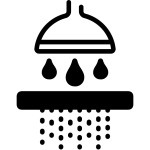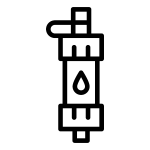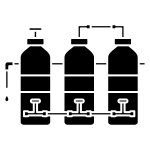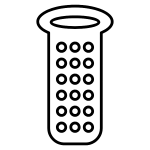Introduction
Winter brings with it cozy nights, hot baths, and beautiful snow—but it also brings the risk of frozen pipes, especially in colder regions. One common piece of advice you’ll often hear from plumbers and home improvement experts is to “drip your faucets” to prevent those pipes from freezing. But when do you need to drip faucets, and is it always necessary?
In this comprehensive guide from Cuoll, your trusted source for water filters, purifiers, bathtubs, and home plumbing solutions, we’ll explore:
- What it means to drip your faucets
- Why dripping faucets prevents freezing
- The exact temperatures when you should take action
- Which faucets to drip
- How to safely drip faucets
- Other ways to prevent frozen pipes
- Recommended Cuoll plumbing products
Whether you’re a first-time homeowner or just looking to protect your home’s water system, this blog has everything you need to know.
What Does “Dripping Faucets” Mean?
Dripping faucets involves leaving a small, steady trickle of water running through selected faucets—especially those connected to pipes that run through unheated or poorly insulated areas. The goal? Keep the water moving to prevent freezing.
A frozen pipe can burst, resulting in costly water damage, repairs, and temporary loss of water access. By dripping faucets, you relieve the pressure buildup that occurs when water turns to ice inside the pipe.
Why Should You Drip Faucets in Cold Weather?
Water expands as it freezes. If the temperature drops low enough, the water in your pipes can freeze and expand—causing your pipes to crack or burst. Dripping water through the faucets:
- Keeps water moving through your pipes, reducing the chance of freezing
- Relieves pressure in the system if freezing begins
- Provides a simple, cost-effective solution that can save you thousands in repair bills
Fun Fact:
According to the Insurance Institute for Business & Home Safety (IBHS), a burst pipe can cause more than $5,000 in water damage on average.
When Do You Need to Drip Faucets?
This is the most important question for homeowners. You don’t need to drip faucets every day in winter—only under specific conditions.
✅ Drip your faucets when:
- Outside temperatures are expected to drop below 20°F (-6°C)
- You have exposed or uninsulated pipes
- You’re away from home during freezing weather
- Your home has a history of frozen pipes
- There’s a wind chill advisory (wind can cool pipes faster)
- You live in a region not used to extreme cold
🛑 No need to drip faucets when:
- Temperatures remain consistently above freezing (above 32°F or 0°C)
- Your pipes are properly insulated and heated
- You have a frost-proof plumbing system installed
Which Faucets Should You Drip?
Not all faucets need to be dripping. Focus on strategic locations that are at risk.
1. Farthest Faucet from the Main Line
This ensures water is flowing throughout your entire plumbing system.
2. Faucets Along Exterior Walls
Pipes near exterior walls are more exposed to the cold and freeze faster.
3. Faucets in Unheated Areas
Such as:
- Garages
- Basements
- Attics
- Crawl spaces
- Laundry rooms
4. Hot and Cold Water Lines
Open both hot and cold valves slightly to keep both lines moving.
How Much Should You Drip?
You don’t need to run the faucet at full flow. A slow, steady drip—about 5 drops per second—is usually enough.
This minimizes water waste while still keeping the pipes protected.
💡 Tip from Cuoll: Consider placing a small bucket or basin in the sink to reuse the water for houseplants or cleaning.
When to Stop Dripping Faucets
You can stop dripping faucets when:
- The temperature is consistently above 32°F (0°C) for more than 24 hours
- The cold spell has passed
- Daytime temperatures are well above freezing, even if it dips at night
Additional Tips to Prevent Frozen Pipes
Dripping faucets is just one way to protect your plumbing. Here are other expert-approved strategies:
1. Insulate Exposed Pipes
Use foam pipe insulation, heat tape, or thermostatically controlled heat cables.
Cuoll Pro Tip: Check out our pipe insulation accessories and plumbing support kits in the Cuoll store.
2. Seal Air Leaks
Inspect and seal gaps around windows, doors, and where pipes enter walls.
3. Open Cabinet Doors
Let warm air circulate around bathroom and kitchen pipes by keeping cabinet doors open.
4. Keep the Heat On
Even if you’re away, set the thermostat to no lower than 55°F (13°C).
5. Install a Smart Thermostat
Smart thermostats help you monitor your home’s temperature remotely—even while traveling.
6. Shut Off Outdoor Faucets
Disconnect hoses and drain outdoor water lines before winter.
Cuoll’s Recommended Winter Plumbing Products
At Cuoll, we believe in preparing your home for every season. Check out these winter plumbing essentials:
🛁 Water Filters & Purifiers
Keep your water clean and flowing smoothly—even during winter.
- Sediment Filters
- Activated Carbon Filters
- Cartridge Filter Housings
🚿 Smart Shower Filters
Protect your skin from hard water in the dry, cold months. Cuoll’s shower filters soften water and reduce chlorine—great for winter skin!
🔧 Pipe Insulation Kits
Insulate your pipes with Cuoll’s easy-to-install insulation sleeves.
🛠️ Faucet Drip Kits
Adjustable valve kits make it easier to control faucet drip and reduce water waste.
Frequently Asked Questions (FAQ)
1. Does dripping faucets waste a lot of water?
Not significantly. A slow drip uses about 1 gallon per hour, but that’s a small price compared to costly water damage repairs.
2. Should I drip faucets even if I have a well?
Yes. Whether you’re on city water or well water, pipes can freeze. Keep at least one faucet dripping, preferably near the pressure tank or pump.
3. Should I drip upstairs or downstairs faucets?
Drip the lowest faucet in the home. Water will flow through all pipes above it, helping protect the whole system.
4. Can bathtubs and showers be used for dripping?
Yes! Set your tub or shower faucet to a small drip if it’s near an exterior wall or in an unheated bathroom.
5. Will a dripping faucet prevent all freezing?
It helps significantly, but not always. Combine it with pipe insulation and proper heating for maximum protection.
Conclusion: Be Proactive, Not Reactive
Knowing when you need to drip faucets is essential knowledge for every homeowner. With proper preparation, you can prevent frozen pipes, avoid expensive repairs, and enjoy a stress-free winter.
At Cuoll, we’re here to support your home’s water system with high-quality products—from water filters and purifiers to plumbing accessories and bath fixtures.
✅ Visit Cuoll.com to explore our full range of winter-ready home improvement products and stay ahead of seasonal plumbing issues
Quick Recap Checklist ✅
- ❄️ Drip faucets when temperatures drop below 20°F (-6°C)
- 🚰 Focus on faucets near exterior walls or in unheated areas
- 🔥 Drip both hot and cold lines
- ⛔ Stop dripping when temps stay above freezing
- 🧰 Use Cuoll pipe insulation and water filters for extra protection
Optimize Your Plumbing for Every Season — With Cuoll
Don’t let the cold catch you off guard. Bookmark this guide and share it with friends and family this winter. And remember, Cuoll is your one-stop shop for all things water, plumbing, and bath essentials.
Have a question? Leave a comment or contact our support team today!







